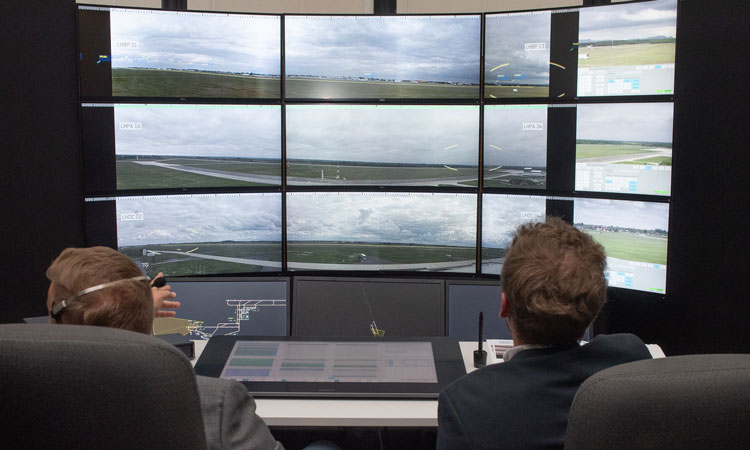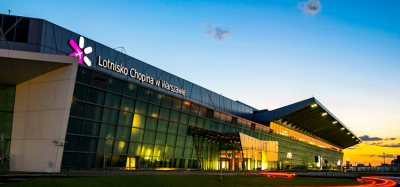The rise of multi-remote towers
- Like
- Digg
- Del
- Tumblr
- VKontakte
- Buffer
- Love This
- Odnoklassniki
- Meneame
- Blogger
- Amazon
- Yahoo Mail
- Gmail
- AOL
- Newsvine
- HackerNews
- Evernote
- MySpace
- Mail.ru
- Viadeo
- Line
- Comments
- Yummly
- SMS
- Viber
- Telegram
- Subscribe
- Skype
- Facebook Messenger
- Kakao
- LiveJournal
- Yammer
- Edgar
- Fintel
- Mix
- Instapaper
- Copy Link
Posted: 27 April 2021 | Rainer Kaufhold, Regina Bruzek | No comments yet
Digital remote towers help to leverage shared assets, improve efficiency, and enable new concepts of operations. Regina Bruzek, Frequentis’ Remote Tower Expert and Rainer Kaufhold, Research and Development Expert at DFS Deutsche Flugsicherung, talk to International Airport Review about the latest validation results, future scenarios and operational excellence.


Passive shadow operations at HungaroControl
How can I picture a multiple remote tower working position?
Regina Bruzek: Multiple airport operation is targeted towards airports with lower traffic numbers. In a multiple remote tower set-up, one Air Traffic Control Officer (ATCO) is in charge of two or more airports simultaneously. The working position includes an arrangement of several stacked rows of screens for a panoramic view. A pan‑tilt‑zoom camera replaces conventional binoculars with additional zoom settings, while hotspot cameras provide supplementary views on runway, taxiways, and apron. Surveillance and flight data information with planning strips for each airport complete the multiple position set-up. Although the working position supports assistance on-demand, one single ATCO will be managing all airports assigned to the physical working position during regular operation. The concept was developed in iterations involving several human factor teams, and assessments were conducted throughout the entire design process.
So how would you define multiple remote towers from an operational side?
Rainer Kaufhold: At airports with low traffic numbers the ATCO has additional working capacity. Multiple remote tower concepts allow the allocation of two or more airports to one working position, this increases ATCO productivity. The possibility of transferring airports from one working position to another ensures that the workload for the ATCO at each of the working positions remains balanced.
The key to multiple remote towers is the ergonomic design of the ATCO working position, enhancing situational awareness and improving the efficiency of controller workload as much as possible. In the Single European Sky ATM Research (SESAR) project on multiple remote towers this was addressed during recent years by several partners and was validated in various real-time simulations by ATCOs from different Air Navigation Service Providers (ANSPs).
The prototype developed by DFS and Frequentis is characterised by a high level of system integration (related to flight data processing (FDPS), surveillance and video systems) providing the ATCO with information required for specific situations. The prototype is also focused on support functionality guiding ATCO’s awareness during normal and abnormal situations. Development and validation of the prototype has received funding from the SESAR Joint Undertaking.
What is Frequentis DFS Aerosense’s experience with multi-remote tower solutions?
Bruzek: Frequentis DFS Aerosense’s parent companies, DFS and Frequentis, were involved in numerous SESAR validations for different European ANSPs in Germany, Hungary, Lithuania and Poland. Frequentis DFS Aerosense, which adapts its solutions to civil and military demands, successfully ran five simulator validations and one live validation in 2019 with a real-time working position in Budapest for three local Hungarian airports. Extensive experience was further gained through simulator runs testing standard and non-standard situations during heavy snowfall, panorama display failure using low-visibility procedures, specific wind phenomena and emergency procedures. An excellent composition of sophisticated multiple remote tower functionalities paired with slick design of support functions resulted in a smooth and easy to use operating position covering all aspects of ATC.
Which support functions are helpful when operating multiple airports at the same time?
Bruzek: The latest Frequentis voice communication system ensures seamless data exchange between all applications available at a multiple remote tower position as voice, video, flight data and surveillance information systems are all based on one common platform. This integrated approach permits data exchange between applications to minimise workload, while maximising the ATCO’s situational awareness. Frequentis developed a number of different support tools for multiple remote tower control to ensure safe operation: with airport-related radio transmission indicated on the user interface, the operator has immediate orientation to find corresponding flight plan information.
Additionally, a planning tool for scheduling traffic along a timeline and panoramic overlays related to the runway in use, weather and moving objects derived from surveillance information, ease the distinction of information. We are further looking into solutions to support the centre management of multi-airport working positions. With a centralisation of airport units, supervisors are required to allocate roles and staff to cope with demanding traffic situations at one location, while providing ATC services for average traffic situations elsewhere. Being prompted for changes in weather situations, traffic volume or staff availability helps keep centre operations smooth and efficient.
With all these support functions available in a multiple airport environment, how did ATCOs respond to the new situation of a triplication in airports they oversee?
Bruzek: First, all operators were familiarised with the new systems and agreed procedures to bring them up to the same functional skill level. During the first training session, the general handling was well practiced and the ATCOs were quickly able to run the exercises facing common situations. With every additional exercise they gained confidence and trust in the system and were quickly able to manage more demanding situations. It was interesting to observe how fast the operators were able to adapt. They had progressed from a multi-operation rookie to eventually handling traffic numbers way beyond the average for these airports, while testing their limits in a simulated environment. Of course, with three airports in operation, the combined frequencies were quite occupied, but frequency congestion would have been comparable to a single remote tower with the same traffic numbers. Contrary to all expectations, the airports were never mixed up. The combination of various support functions always gave ATCOs a clear air traffic picture.
With a view on regulatory requirements, what aspects are most important in implementing multi‑remote towers?
Kaufhold: As early as September 2016 the EUROCAE Working Group 100 (WG-100), dealing with remote and virtual towers, published the initial version of ED-240, ‘Minimum aviation system performance specification for remote tower optical systems’. These standards specified the end-to-end performance of the optical (camera) system. The requirements set forth by EUROCAE ED-240/ED-240A/ED-240B are applicable to single and multiple mode of operation.
In February 2019 EASA RMT.0624 issued ‘guidance material on remote aerodrome air traffic services’ replacing the previously published EASA guidance from 2015. This new updated guidance takes into consideration the further evolution of the concept as well as experiences gained from R&D activities (e.g., all the SESAR 1 validation activities and solutions). It shows initial implementations throughout the European Union and the United States and addresses also multiple and more complex modes of operation. Thus, the regulatory framework needed for multiple mode of operation is now in place. In 2020 EASA started the RMT.0624 again and the work to bring the guidance material to the next level is still ongoing.
Also, in 2020 ICAO founded a subgroup (Remote Air Traffic Service Subgroup RATSSG) of the ATMOPS Panel, dealing with remote and digital tower aspects. This work is still in its early stages. The main focus of the first step will be the identification of change requirements in some other ICAO documents like PANS-ATM or PANS-AIM in order to not hinder future development but always having the same safety level as using conventional towers.
Since more and more airports around the world start to notice the benefits of multi-remote towers. What’s next for DFS?
Kaufhold: DFS currently provides air traffic services to Saarbrücken Airport, in South West Germany, from the remote tower centre in Leipzig, Eastern Germany, 450km away. Erfurt Airport is scheduled to follow this year with Dresden complementing the remote tower centre in the next step.
Cross-licencing will enable the ATCOs to provide air traffic services (ATS) to all the airports within the remote tower centre, consecutively but not simultaneously at this stage. However, this will allow the more efficient employment of the ATCOs.
The ATCOs already being used to the remote tower technology as well as being familiar with the specific procedures of the specific airports, is a major cornerstone which will support the next step leading to multiple remote towers. In addition, the development of multiple remote towers within SESAR provides a sound basis for a future deployment of the multiple remote tower operations.


Regina has been involved in shaping Multiple Remote Tower positions and centre solutions throughout various SESAR and customer projects. With an air traffic control (ATC) background she has extensive experience in designing and evolving user interfaces for voice communication systems and support tools for nearly 20 years, which strongly influenced the successful development of multiple remote working positions suitable for tower and approach control.


Rainer has an engineering background and after his thesis on ergonomic design on terrain presentation in flight guidance displays, he joined DFS research and development department in 1998. He has been responsible for several national and international airport-related projects like on integration of arrival and departure manager (AMAN and DMAN) as well as human machine interface (HMI) design for a Flight Data Processing System. His focus is now on development of remote tower applications within the SESAR programme.
Issue
Related topics
Air traffic control/management (ATC/ATM), Digital transformation, Remote digital towers


















